Far away from civilization and with only a few people around: these hidden gems are the epitome of natural beaches in Mallorca. While reaching those virgin and secluded beaches of Mallorca may require some effort, the reward of bathing in an untouched oasis, potentially even without any other people around, makes it all worthwhile.
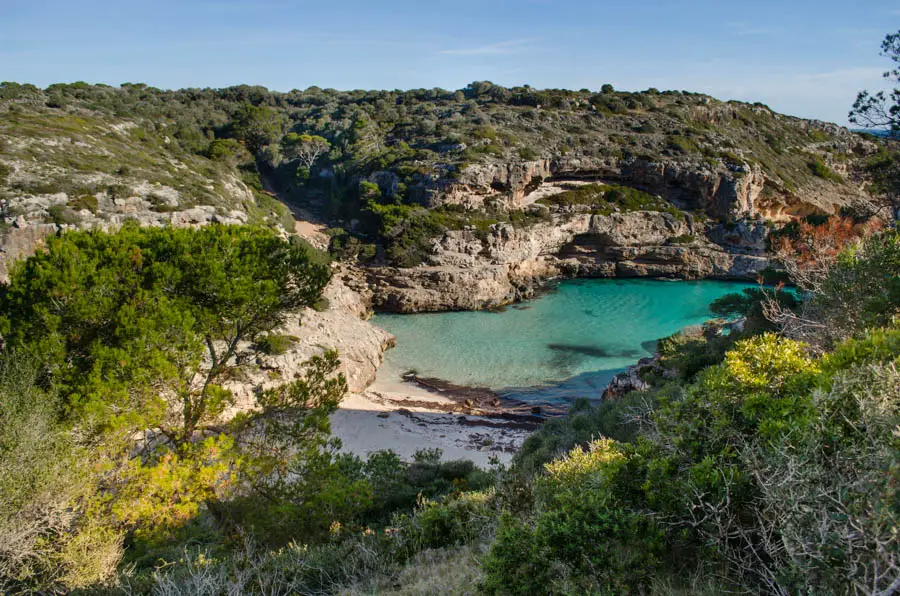
Transparency note: Some links in this post may lead to external booking opportunities. If a purchase is made, we receive a small commission. The price does not change for you.
Despite Mallorca being widely developed for tourism, there are still quite a few areas that remain untouched and should continue to stay that way. Among them are many beaches that are almost deserted and often hidden away. These secluded havens offer peaceful retreats where one can truly grasp the essence of Mallorca as it once was, before tourism took hold. In this article, I present to you seven of the most stunning secluded beaches of Mallorca.
7 Secluded Beaches in Mallorca
Cala Figuera de Formentor
We begin our journey in the north with the first natural beach in Mallorca, located within the municipality of Pollença. On the way to the lighthouse at Cap de Formentor, there is a small bay that ranks among the most popular on the peninsula. This is the Cala Figuera Beach, not to be confused with the fishing village of the same name in the southeast of Mallorca.
With its turquoise waters and expansive sandy seafloor, Cala Figuera stands out amidst the distinctive cliffs, extending all the way up to the main road. Its beauty entices numerous visitors, many of whom may not even know the name of the bay. However, they are truly captivated by the small, rocky bathing area that awaits them.
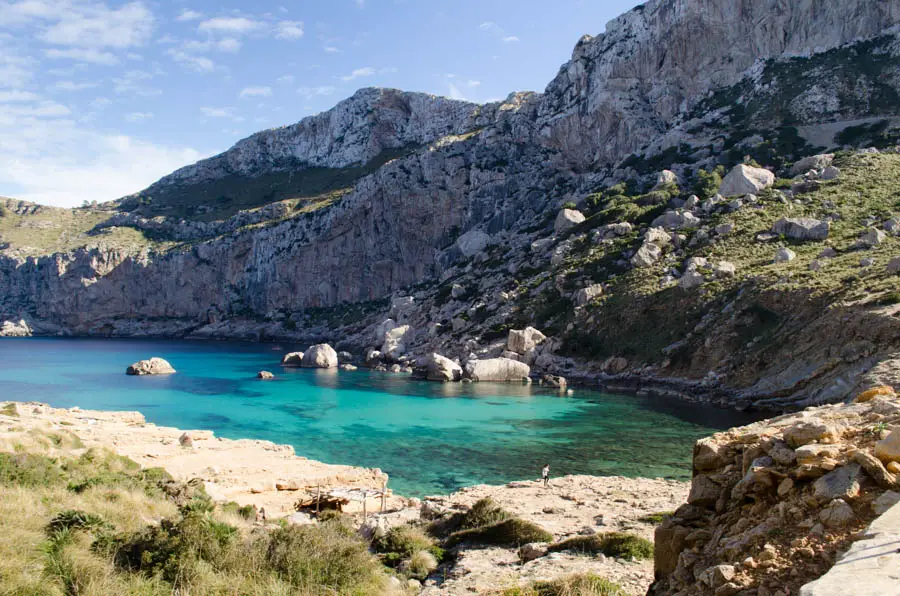
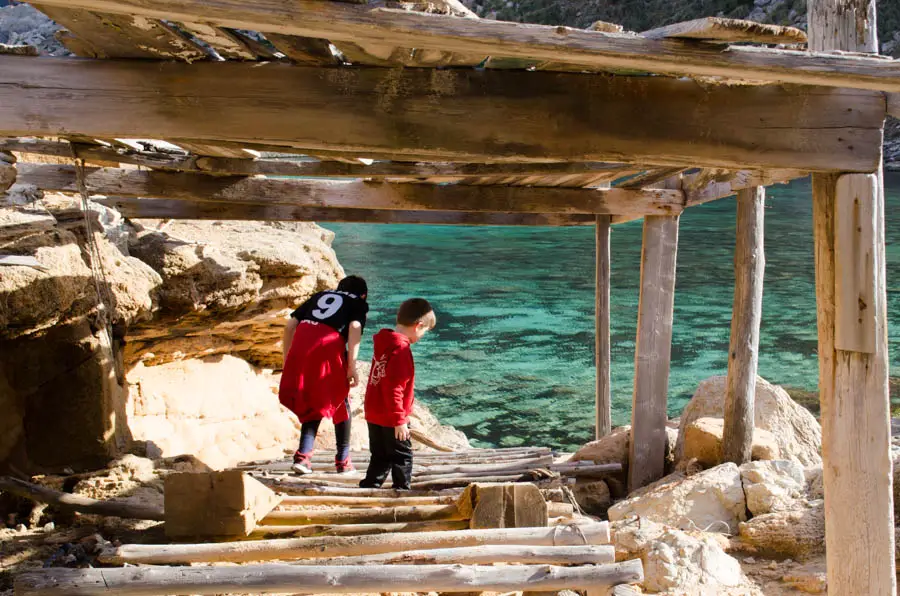
Cala Figuera de Formentor is relatively easy to reach, considering its untouched nature. However, it’s not without its challenges. It can be accessed from Port de Pollença via the MA-2210 road. This is the same road where during the peak season, long queues of cars squeeze through and traffic occasionally comes to a standstill at certain bottlenecks. As a result, the road is closed to traffic during the daytime in the summer. Fortunately, there is a regular bus service departing from Port de Pollença that stops at all the other highlights along the way.
At kilometer 12, drivers turn onto a gravel road. In theory, you could continue driving all the way to the bay and park there. However, if you want to preserve your vehicle, it is advisable to park along the road and walk the final kilometer on foot.
Cala Boquer
The little sister of Cala Figuera, Cala Boquer, offers its own unique adventure. The descent to Cala Boquer is an adventure in itself, making it suitable for families, including those with young children. Parking is easy to find, and the slightly more than two-kilometer walk is pleasant.
The beach itself is rocky and often covered with Posidonia, also known as Neptune grass. It’s a beautiful and wild corner that offers plenty of excitement for both young and adult adventurers. Those brave enough to venture into the water and swim through the seagrass will be rewarded with clear waters and a fine sandy seabed.
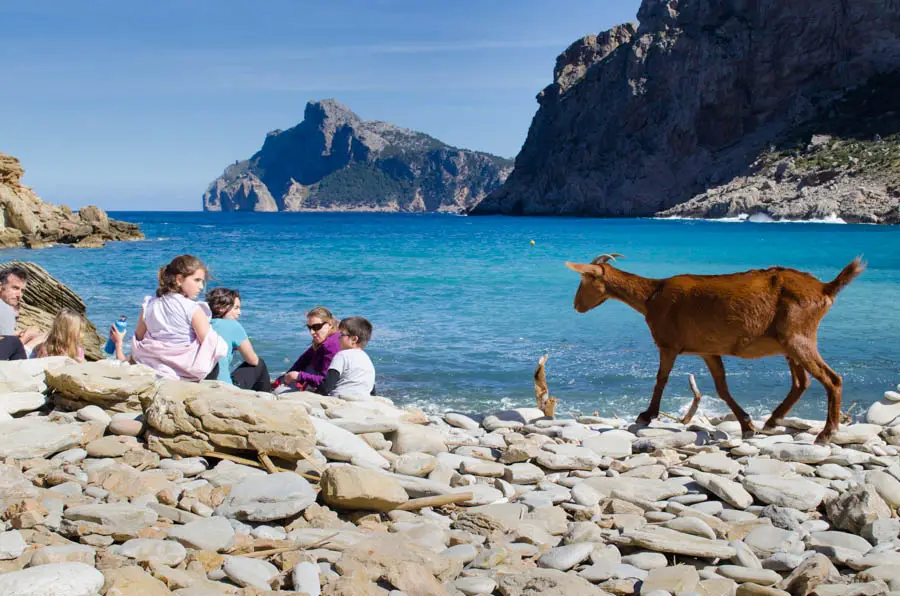
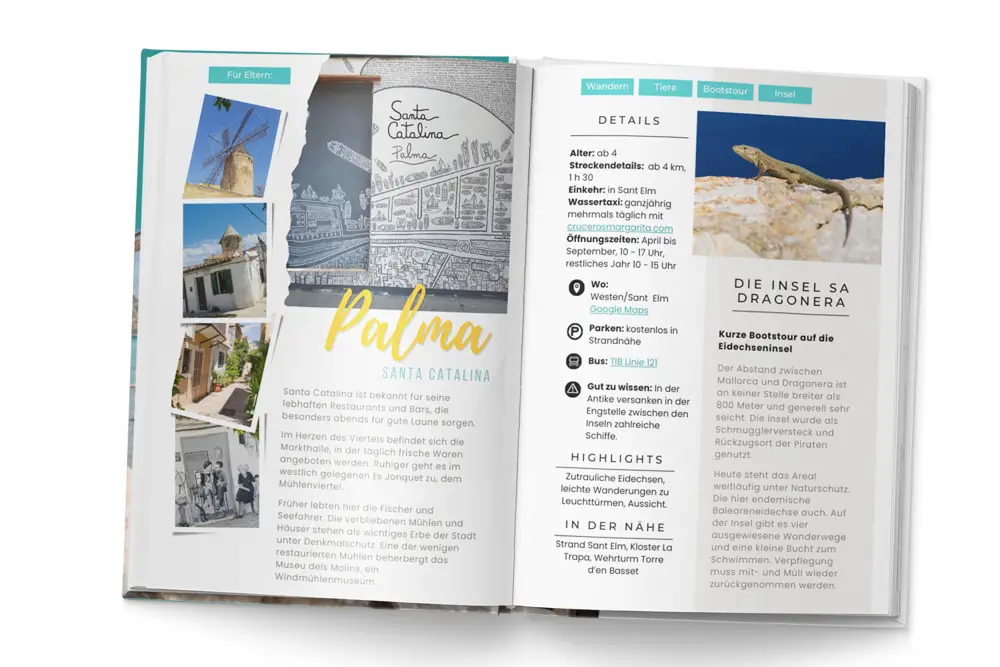
Du liebst diese Tipps?
Entdecke alle kinderfreundlichen Aktivitäten, Strände und exklusive Rabatte in meinem Mallorca-Guide.
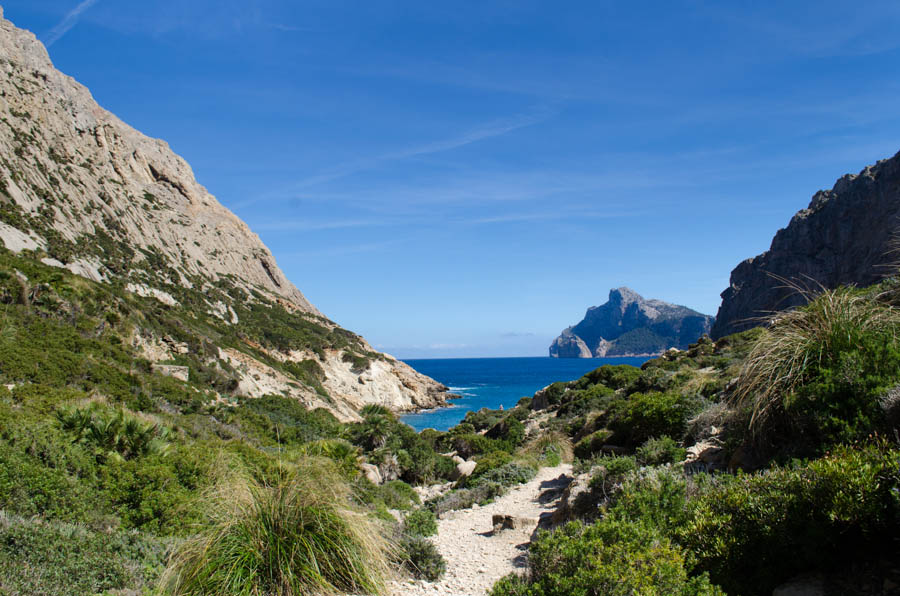
The name of the bay, Cala Boquer, is derived from Bocchoris, a former Roman settlement that, along with Pollentia (now Alcúdia), formed the Roman core in the northeastern part of the island.
Since 2001, archaeologists have been working on the site of the ancient settlement, uncovering structures from the 4th century, as well as rare fossils and a Roman contract. All these discoveries can be viewed at the museum in Pollença.
Platja des Coll Baix
Book a Boat Tour to Coll Baix: Reserve Your Tickets Here
The formation of Coll Baix beach is attributed to a natural catastrophe. It is believed that a coastal landslide occurred, possibly triggered by heavy rains, resulting in the creation of this unique landscape. The seabed here is dark and rugged, while the sand appears almost black. Due to its unsuitability as an anchorage, the bay remains mostly secluded, making it a haven for solitude-seekers.
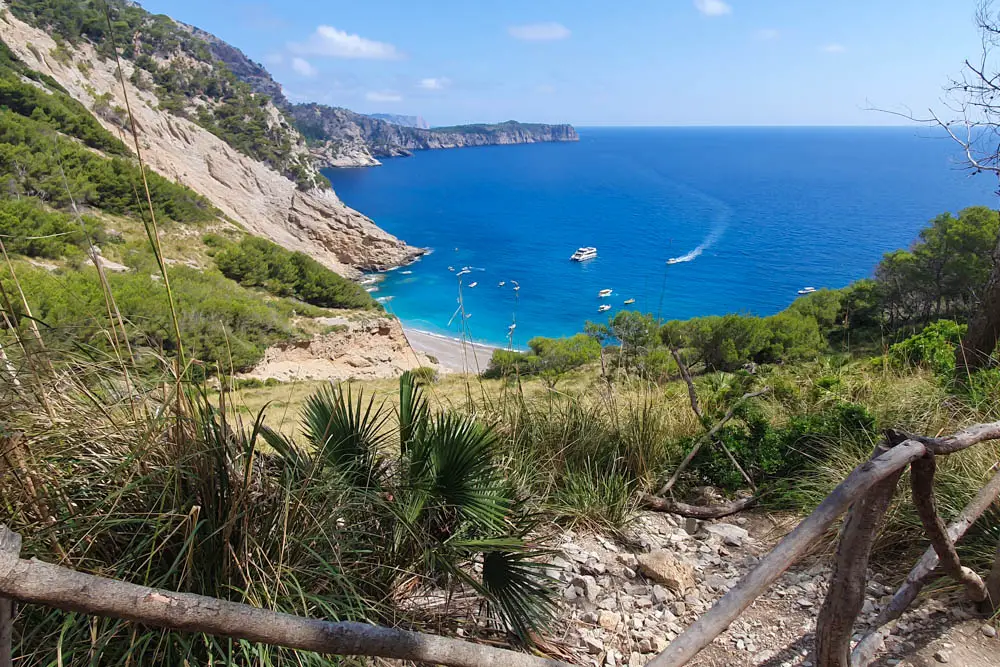
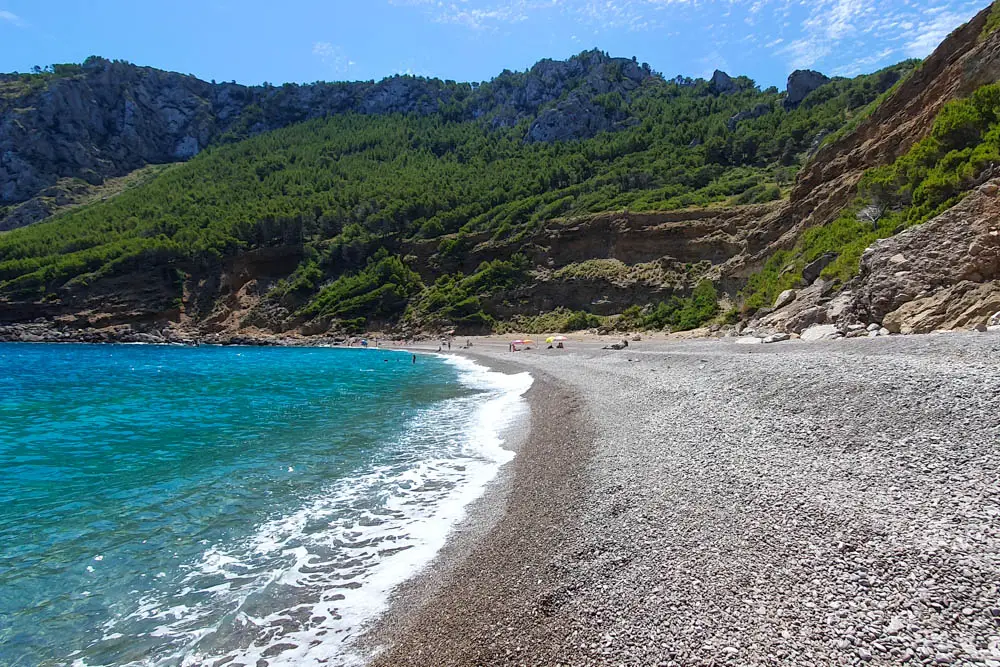
In comparison to many other natural beaches, Coll Baix in the east is somewhat of a peculiar exception. Yet, it is a true gem in its own right, albeit not the easiest to access. For those confident in their driving skills and their vehicle’s capabilities, it is possible to drive to a shelter with a parking area nearby. From there, it’s roughly a kilometer on foot, with most of the path descending steeply along the cliffs. The trail is quite challenging, so if you plan to hike with children, exercise caution and ensure that everyone is surefooted and not afraid of heights.
Your reward is an unspoiled paradise and a sense of near-perfect solitude. The only potential intruders, if any, are a few mountain goats that might curiously eye your picnic.
Cala Mitjana / S’Aduaia
Nestled in the heart of the Península Llevant Natural Park, you’ll find a true hidden gem, a natural beach that can be reached by car for up to 100 meters, yet has remained completely untouched. As if that weren’t luxurious enough, it boasts pristine white sandy shores and a backdrop of rolling hills.
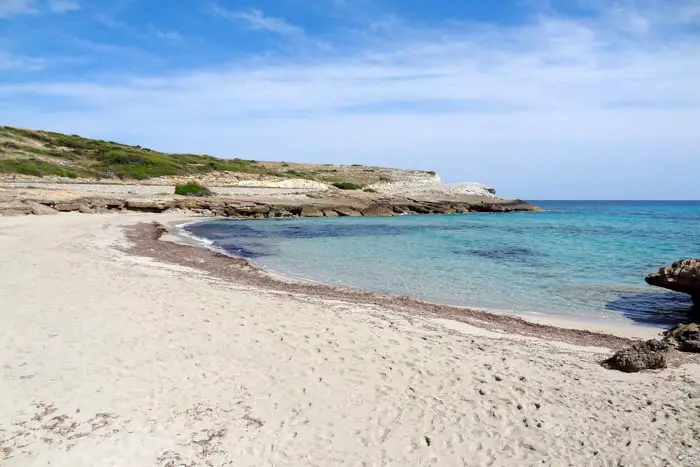
If it were up to speculators, the area would have been developed by now. However, the necessary groundwater resources were not found, preventing any extensive construction. As a result, the invasion of buildings was limited to marginal paths, much to the benefit of beach goers who can reach the shoreline more or less easily.
You should not expect paved roads, though. The path is bumpy and uneven, but the effort is well worth it. Alternatively, to preserve your vehicle, you can also access Cala Mitjana by walking along the coast from Cala Mesquida. For those seeking more adventure, you can continue in the opposite direction within the bay, towards the equally beautiful beaches of Sa Font Celada and Arenalet des Verger.
Caló des Marmols
The Marmors Bay is another gem, this time located in the southern part of the island. It is situated halfway between Cap de Ses Salines, which marks the southernmost point of Mallorca, and the bays of Cala S’Almunia / Caló des Moro. The latter is often advertised as one of the most beautiful natural coves on the island, but we intentionally exclude it here.

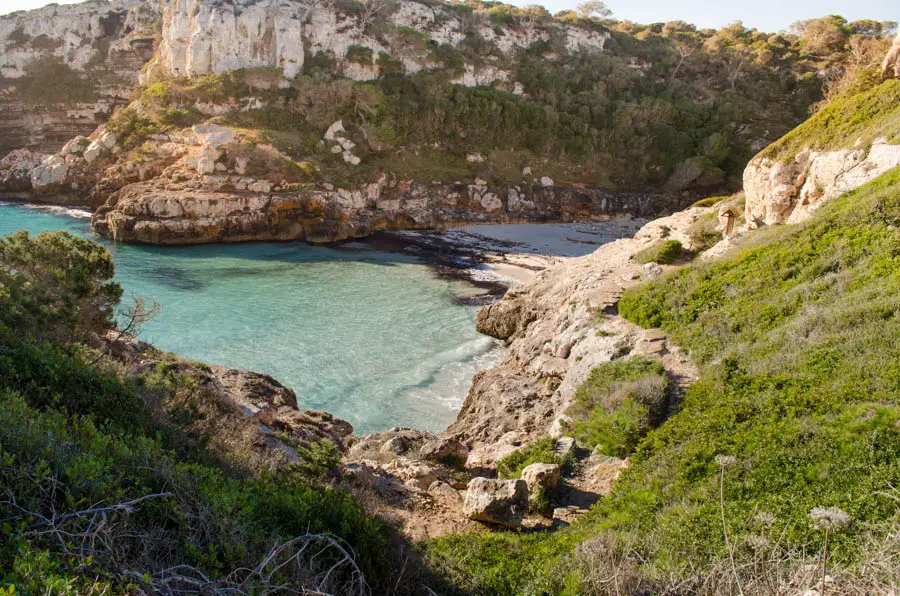
To reach Caló des Marmols, you first need to decide which side to start from. The distance is approximately the same from both sides. It’s advisable to allocate about two hours for the round trip, making it a challenging but worthwhile endeavor.
We personally prefer the route from Cala S’Almunia. There, you can discover abandoned towers and old agricultural buildings that add a touch of variety to the journey. However, it doesn’t mean that the route from the other side is boring. The path always follows the rugged coastline, and you’ll rarely want to put your camera down. Remember to bring enough water and sunscreen, and start your hike early to avoid the midday heat. The trail should not be underestimated.
Platja d’Es Caragol
While it may be our subjective opinion, we firmly believe that the most beautiful beach in Mallorca is Platja d’es Caragol. Although you may encounter seagrass both in the water and on the shore, the beach is so expansive that you can always find a cleared area of sandy beach somewhere.
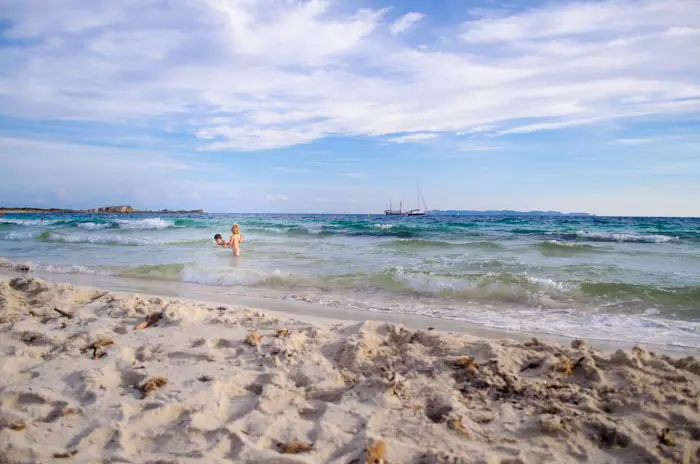
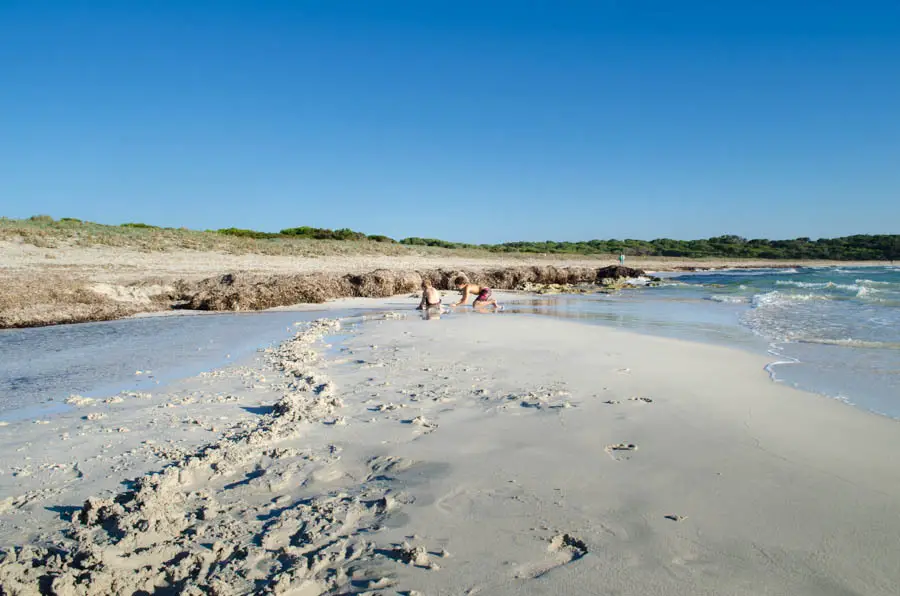
It bears some resemblance to Playa Es Trenc, albeit smaller and less crowded. This is largely due to the fact that Es Caragol can only be reached via a 20-minute walk from Cap de Ses Salines. The path is straightforward, but should not be undertaken during the midday heat.
Aside from its slightly challenging accessibility, Es Caragol is a classic family-friendly beach. The shoreline slopes gently, and there are sandbanks that extend far into the sea, making it a bit tricky to swim properly. In the hinterland, children can climb on bunkers from the Spanish Civil War, and a little further south, there is a small island that can be reached on foot.
Playa Es Trenc
The longest stretch of continuous sandy coastline in southern Mallorca can be found between Sa Ràpita and Colonia de Sant Jordi. Es Trenc is undoubtedly the most famous beach on the island and is featured in countless travel reports. As a result, it attracts increasing numbers of visitors, leading to challenging traffic conditions. Despite efforts to expand parking facilities and introduce bus shuttle services, the situation remains chaotic.
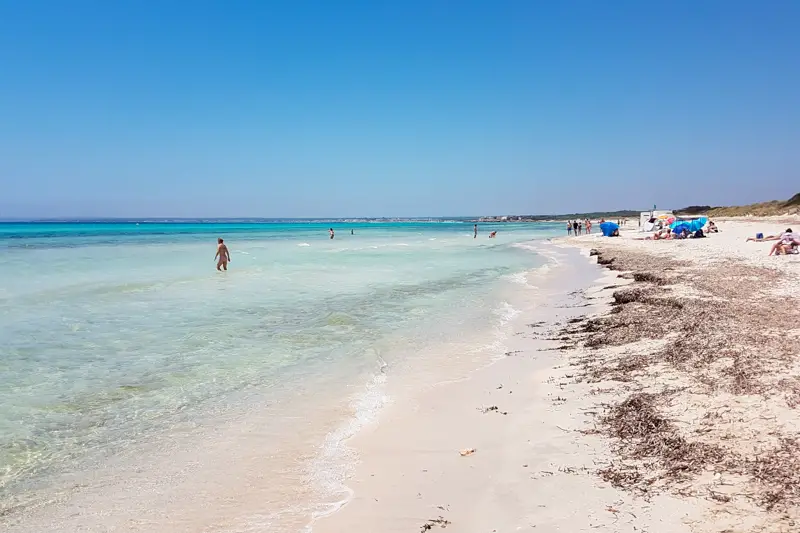
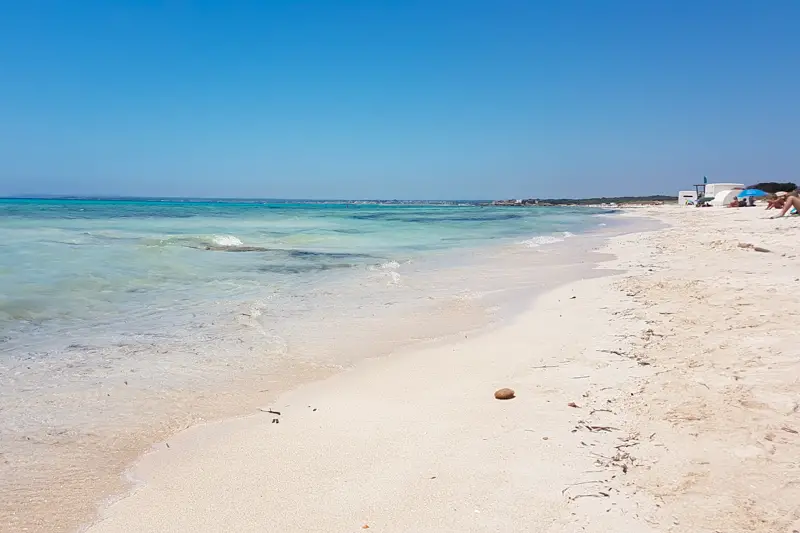
However, what often bothers most visitors is the presence of seagrass along the shoreline. This is also why I will address the essential characteristic of natural beaches further below.
While we do appreciate Es Trenc, there are other beaches that we prefer, mainly because they are less crowded. However, we enjoy coming here in the evening hours when it’s easier to find parking, and the overall atmosphere becomes calmer and more relaxed.
To first-time visitors, I recommend keeping their expectations in check before their initial visit. The beach is beautiful, but it is just one among many. It’s also worth exploring a bit further by taking a walk. Towards the back, you’ll find fewer people and areas where there is no seagrass, allowing you to see Es Trenc as it is depicted in glossy magazines: turquoise waters and white sandy shores.
Boat Trips to the Best Secluded Beaches of Mallorca
Natural Beaches in Mallorca: The Issue with the Seagrass
Recently, I came across reviews from some visitors on various online platforms who had visited Es Trenc and had a rather negative experience. It is natural for opinions about a beach to differ, whether one likes it or not, and whether it lives up to the Caribbean or is simply hyped. However, the reasons provided were quite peculiar: the beach was described as dirty. But not due to litter or human waste, but rather because of algae, they said.
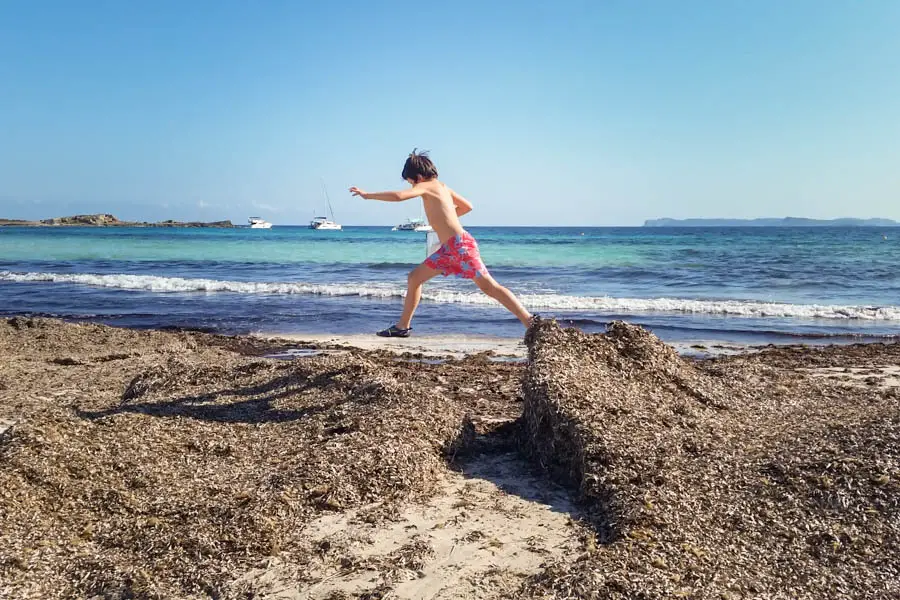
I cannot leave that statement as it is. What everyone finds disgusting and refers to as algae is actually seagrass, specifically Posidonia oceanica. It is the sole reason why the water around Mallorca is clear and clean.
Posidonia seagrass has existed on Earth for over 100,000 years. It was named after the Greek god and is not an algae but a unique organism. It forms underwater meadows that provide a habitat and sustenance for a variety of marine animals, including fish, crustaceans, and mollusks. These green meadows support more than 400 plant species and 1,000 animal species in the Mediterranean underwater world.
During summer, due to heat and human-induced factors, the seagrass undergoes a natural die-off process. It turns brown and drifts to the seafloor, eventually being washed up onto the beaches. Even there, the seagrass serves an important purpose. It acts as a natural barrier, protecting the beach from wind and weather and preventing sand erosion. Without the presence of seagrass, the waves could easily reclaim the beach, which would have significant implications for future beach vacations.
In the past, the dried seagrass leaves were used for insulation in homes and as fertilizer in fields. However, it is now prohibited to remove seagrass from the beach without official permission.
Natural Beaches and Posidonia under Nature Protection
Thanks to an increasing sense of responsibility and a growing interest in the environment, Posidonia seagrass is receiving more attention. As a result, it is no longer cleared away when the holiday season begins at Es Trenc. Boat owners are also being closely monitored to prevent damage caused by anchors tearing up entire seagrass meadows. Such damage takes many years to regenerate. There is a nautical chart indicating areas marked as Posidonia meadows, which are designated as no-anchor zones.
Do you still find seagrass disgusting? I can understand that. Sometimes, it does have a strong smell. And I don’t always enjoy wading through it, either. It sticks so persistently to the skin that even showering doesn’t remove it easily. In such cases, there’s only one solution: visit a restaurant with a pool or one of the many water parks in Mallorca.
More beaches, you say?
Well, if you know what you’re looking for, perhaps we have something for you:
- 8 Family-friendly Beaches
- The Most Beautiful Beaches for Snorkeling in Mallorca
- 7 Hidden Coves in the Bay of Palma
- The Most Beautiful Beaches in Southeast Mallorca
- Our Favorite Beaches in the West and Southwest
- The Best Beach Bars in Mallorca
Read more
Want more recommendations like this? Check out more than 100 day trips and excursions on Mallorca.
Planning your holiday on Mallorca:
Book your Flight here
Great Rental Car Offers